Raising quail for meat and eggs is becoming increasingly popular for both new and established homesteads.
These small birds are great for beginners and provide a lot of eggs and meat for the dinner table.
In this post, we will discuss:
- Reasons to start raising quail
- Different quail breeds
- Where to purchase chicks or hatching eggs
- Equipment needed to start raising quail
- How and what to feed quail
- Common quail predators and how to avoid them
- Quail diseases and treatment
- Frequently asked questions
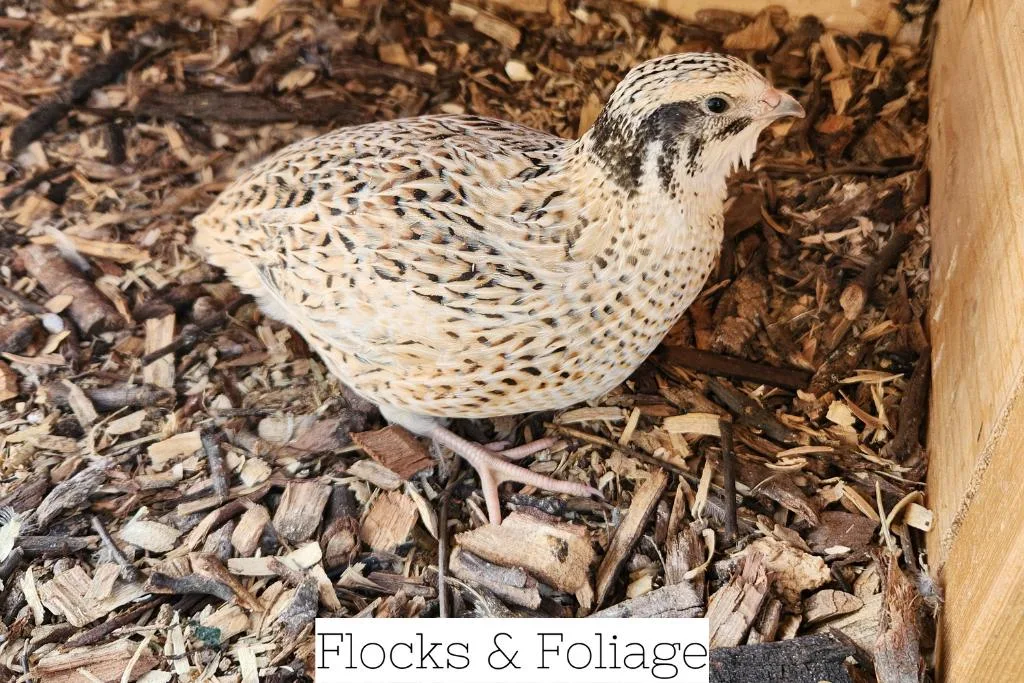
Reasons to Start Raising Quail
Most people say that chickens are the gateway to raising farm animals, but you may find that raising quail might even be better.
Here are a few reasons why that is:
Size
Whether you have a big plot of land or a small backyard, quail do well in both environments due to their compact size.
Although there are a number of different breeds of quail, they are all fairly small in size.
This is great for a few different reasons.
Most cities that ban backyard farm animals (even chickens) do not have restrictions on the amount of quail you can keep.
Because quail are gamebirds, they are not typically considered “farm animals”. Some people even keep them inside as pets.
Quail do not require a lot of space to thrive. Quail only need around one square foot per bird, so you can keep many birds in a small area.
Temperament
Quail are quirky little birds and are fun to watch.
Most quail are docile, although they don’t really like to be held. They are great around kids and will give the whole family a good laugh if you watch them long enough.
Male quail crow, but it is not nearly as loud as a chicken rooster, and the females make pleasant, sweet cooing noises.
Overall, these little birds are a treat to be around.
Eggs
One of the best benefits of keeping quail is their eggs.
Quail produce about 1 egg per day. Their eggs have a very similar taste and texture to chicken eggs.
Quail eggs are however a lot smaller than chicken eggs. About five quail eggs equal one chicken egg.
They also lay their eggs a lot sooner than most other poultry. Females begin laying between 7-12 weeks old compared to a chicken that might start laying at around 20-24 weeks old.
Their eggs are beautiful to look at and keep on the counter. They come in various colors and patterns depending on which breed you have.
And just like chickens, female quail lay eggs whether you have a male in the cage with them or not.
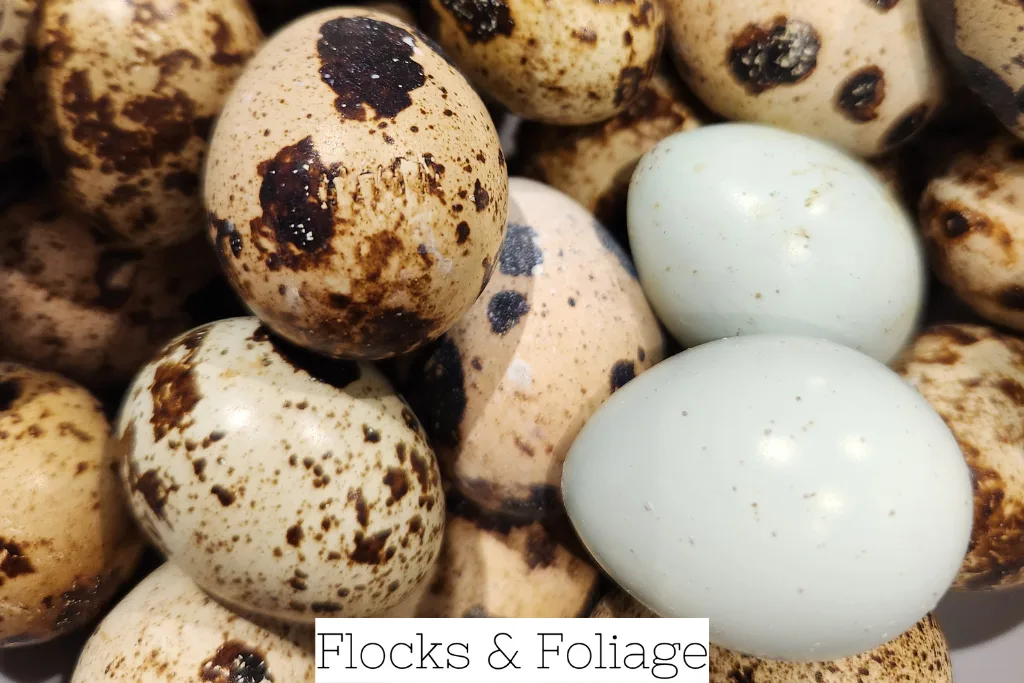
Beauty
Along with quail laying beautiful eggs, quail themselves are rather stunning to look at.
They are small (3-6 oz) and stay fairly close to the ground at all times.
Their plumage comes in all types of patterns and colors. Some quail are even kept and bred as show birds, just like chickens.
Inexpensive
Compared to most other farm animals, quail are fairly inexpensive to keep and maintain.
You can purchase each bird for just a few dollars each and hatching eggs are inexpensive as well.
While quail tend to eat quite a bit, their feed goes a long way. They can also eat some kitchen scraps.
It is easy to get started with quail as they do not require a lot of maintenance as some other animals do.
Hardy
While quail are known to be very accident-prone, they are considered to also be fairly hardy.
They do not become ill very easily and they recover quickly when they are sick or injured.
Quail also thrive in a wide range of different environments and temperatures. They can survive in below-freezing temperatures and are just fine in temperatures over 100 degrees.
Easy to Care For
Quail are very easy to care for. They need food and water available to them at all times.
The daily chores typically involve refilling their food and water each day and cleaning up their waste.
It is also important to keep them out of wind and rain, so you may need to cover their cage or aviary if a storm comes through.
However, you will only need to spend 15-30 minutes each day caring for quail.

Reasons to Raise Quail
Quail are great to raise for many different reasons.
Let’s look at a few reasons that some people choose to raise these fun little birds.
Eggs
As stated above, quail lay about 1 egg per day. That is equal to seven eggs per week just from one hen!
Quail also lay eggs year-round if given the proper light and conditions.
They are tasty to eat and beautiful to keep on the counter.
Meat
Quail meat is both tasty and nutritious. Their meat is considered all dark meat and has a very unique and delicious flavor.
Quail mature quickly and are ready to cull and eat at around 8-10 weeks.
Those that keep quail for meat purposes find that they are fairly easy to cull and prepare as well.
Feathers
Quail feathers are used for many different purposes.
Because quail feathers are so small, some fishermen use them as fishing lures.
They are also beautiful and are sometimes used as crafts to make jewelry to sell at local farmers’ markets or online.
Quail wings can also be clipped and used for dog training and hunting.
Manure
Like other manure, quail manure makes a great fertilizer for gardens or plants.
It is important to properly age and compost it, however, as it is very high in nitrogen and can easily burn your plants.
Adding straw or other compost will create a great compost mixture. After it has been properly aged for a few months to a year, it is ready to apply to plants and crops.
Dog Training
Although it sounds brutal, some people keep quail to help train their hunting dogs.
Some hunters use live birds to teach their dogs to flush out quail and others will simply use quail wings to teach their dogs to hunt.
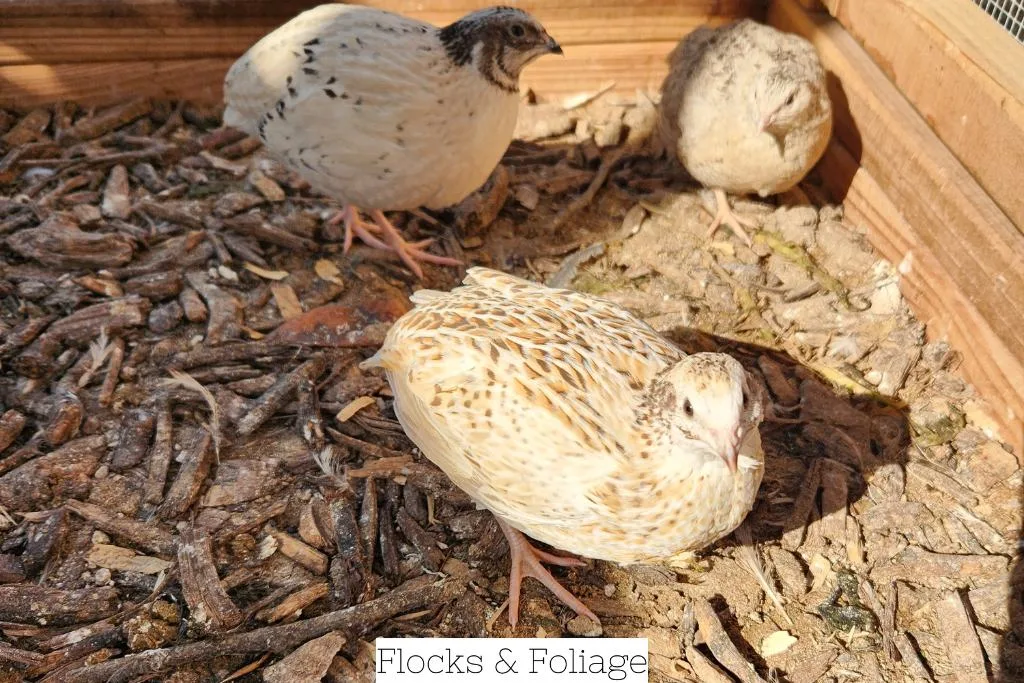
The Downside to Raising Quail
While there are many benefits to raising these fun little birds, there are also some things to keep in mind before getting started with quail.
The Smell
Something to keep in mind when raising quail is that they are pretty stinky.
These birds produce quite a bit of manure. Regardless of whether you keep them in a cage or a large aviary, their poop can stink up an area rather quickly.
When they are kept in cages, it is important to clean the waste pan out almost daily depending on how many quail you keep in a single cage.
In an aviary setting, it is important to turn the ground mulch a few times per week to avoid strong smells.
While the manure makes excellent compost if aged properly, it definitely has a strong odor.
Accident-Prone
While quails are hardy birds and do not get sick easily, they tend to be very accident-prone.
For example, if they are kept in cages that are 3 feet tall or lower, they can jump up and break their neck on the roof when spooked.
They can also drown themselves if their water container is too large.
These little birds will always find new and interesting ways to get themselves injured or killed.
Roosters are Loud
Many claim that these birds are quiet, but that is not always the case.
While quail roosters are not as loud as chicken roosters, their crow is definitely still loud enough to hear from far distances.
If you plan to keep male quail in a small backyard or on your porch, keep in mind that their crow can be heard from indoors quite easily and may annoy your neighbors.
They also crow consistently throughout the day and night and only stop when they are asleep for short periods.
Quail Breeds
When it comes to raising quail, some breeds are going to be much better options than others.
There are over a hundred different breeds of quail. Here are some of the most common ones used for meat and eggs.
Coturnix Quail

Coturnix quail are the most popular breed of quail that are kept as pets and for meat and eggs.
They mature very quickly and start laying eggs between 7-12 weeks of age. They are also mature enough to cull and eat at around 8 weeks of age.
These birds are heavy egg layers and lay around 1 egg per year. Corturnix quail lay year-round when given the proper care and lighting.
It is rare that this breed becomes broody, so you will need to collect and incubate the eggs yourself if you want to keep production going.
Coturnix quail come in a variety of different sizes and plumage colors. Some are even considered “jumbo” and can grow up to 16 oz if you are focusing on meat production.
Their eggs are also fairly large and have a five-to-one ratio to chicken eggs.
Bobwhite Quail
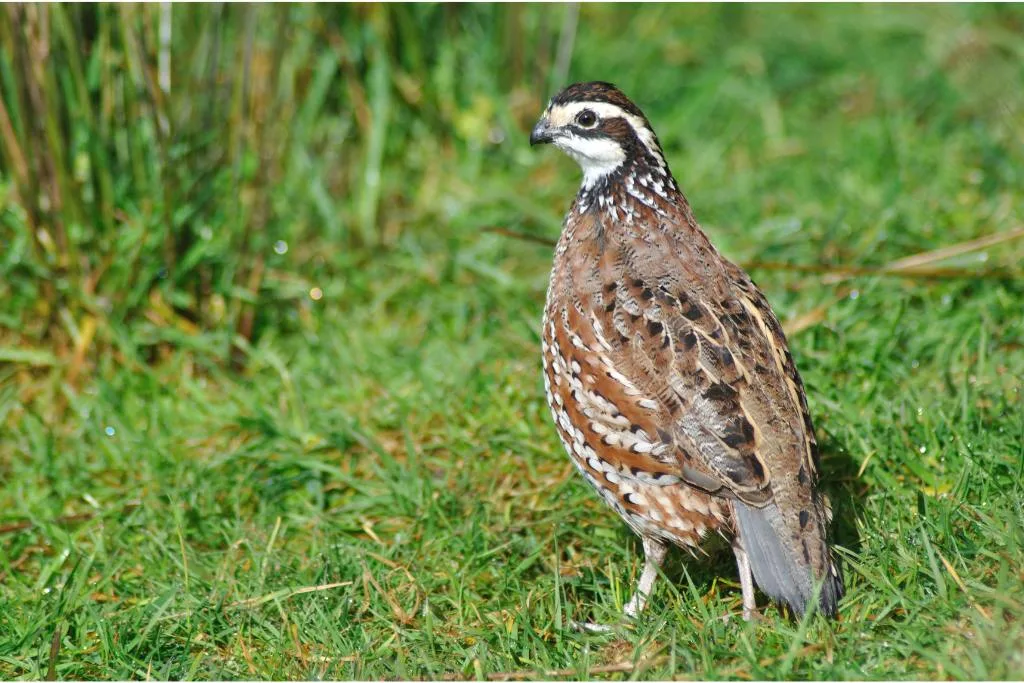
Bobwhite quail are an excellent breed if you are looking for meat and eggs.
They don’t mature as quickly as Coturnix quail, although they do reach about the same size at maturity.
Bobwhites also don’t lay as many eggs as Coturnix either. They lay around 100-200 eggs per year and their eggs can be slightly smaller as well.
It also is not common for Bobwhites to go broody, however, they are more likely to go broody over some other quail breeds. This means you will still need to collect and incubate their eggs yourself.
Bobwhites are a great option for hunters or those looking to train their dogs for hunting as they flush better than Coturnix quail.
They are slightly more agile and will jump off of the ground quicker, making them more challenging to hunt.
Button Quail
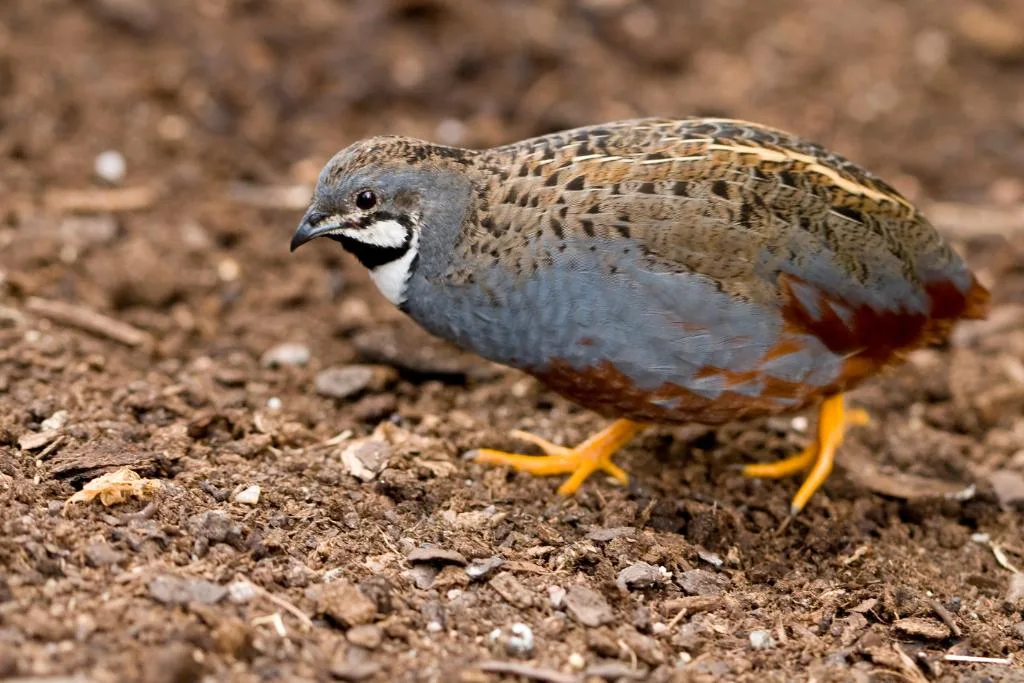
Button quail are significantly smaller in size and are not ideal for meat production or eggs. This breed is typically kept as pets.
Due to their small size, they are much easier to keep in small pens or cages.
They also don’t lay year-round and their eggs are considerably smaller. About ten Button quail eggs equal one chicken egg.
This breed is significantly quieter than other breeds as well so they can easily be kept inside or in small backyards.
Button quail are great options for those who are not overly interested in meat or eggs and would prefer to keep their quail as pets.
Other Quail Breeds
While Coturnix, Bobwhites, and Button quail are the most popular options for homesteaders, there are a few other breeds worth mentioning.
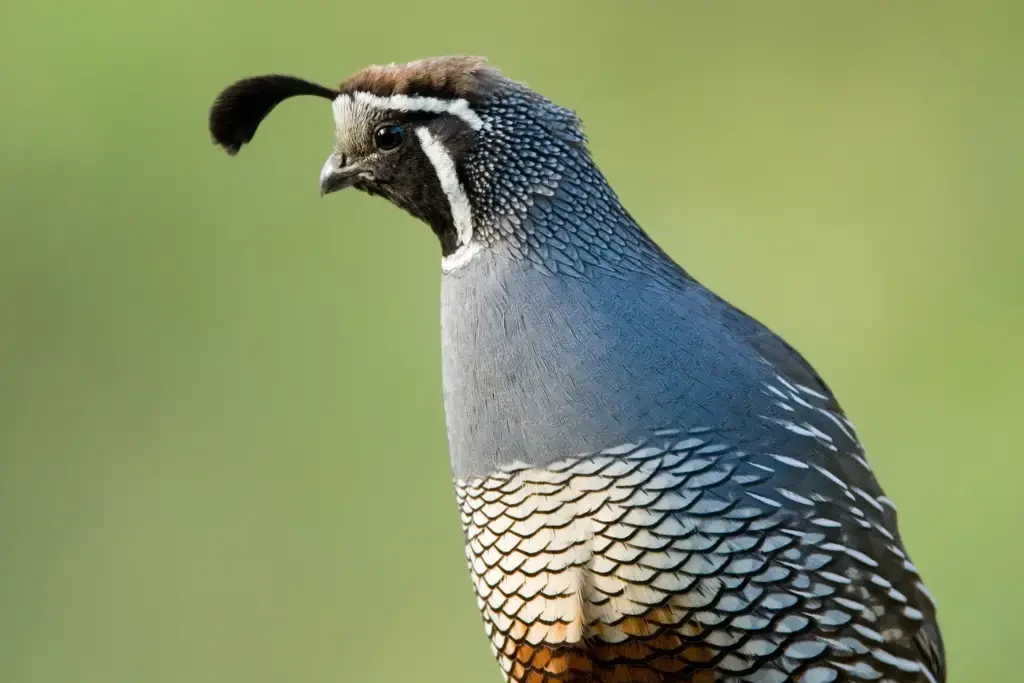
California Quail – Beautiful birds that are typically kept as an ornamental breed. This breed is not great for meat or egg production. This is the breed with the teardrop-shaped plume on top of their head.
Blue Scale Quail – This breed does not do well in confinement and prefers to roam free. Best if you attract them to your backyard and not kept as pets or for meat and eggs.
Where to Purchase Quail
There are a few different options when looking to purchase quail.
Local
It is always best to check locally for live birds or hatching eggs. Anytime you ship livestock, there is a much higher mortality rate with live animals than if you were to pick them up locally.
You will also see a decline in hatch rates if you have hatching eggs shipped to you. The longer the eggs sit out and are not being incubated, the lower the hatch rate will be.
It is best to check your area for any local hatcheries that sell live quail or hatching eggs.
If you don’t have a local hatchery, consider searching on social media groups for people in your area that might be selling live chicks or hatching eggs.
Online
If you don’t have a local hatchery or can’t find anyone locally to purchase from, you may need to purchase your hatching eggs online.
It is never advised to order live chicks through the mail, but there are plenty of places that will ship hatching eggs.
Keep in mind that hatch rates decrease significantly the longer your eggs are in shipping. It is still recommended to have hatching eggs shipped to you from the closest online hatchery possible.
If you are planning to order hatching eggs online, make sure that you have the proper equipment at home first. An incubator should be tested, turned on, and ready to go 24 hours prior to putting the eggs into the incubator.
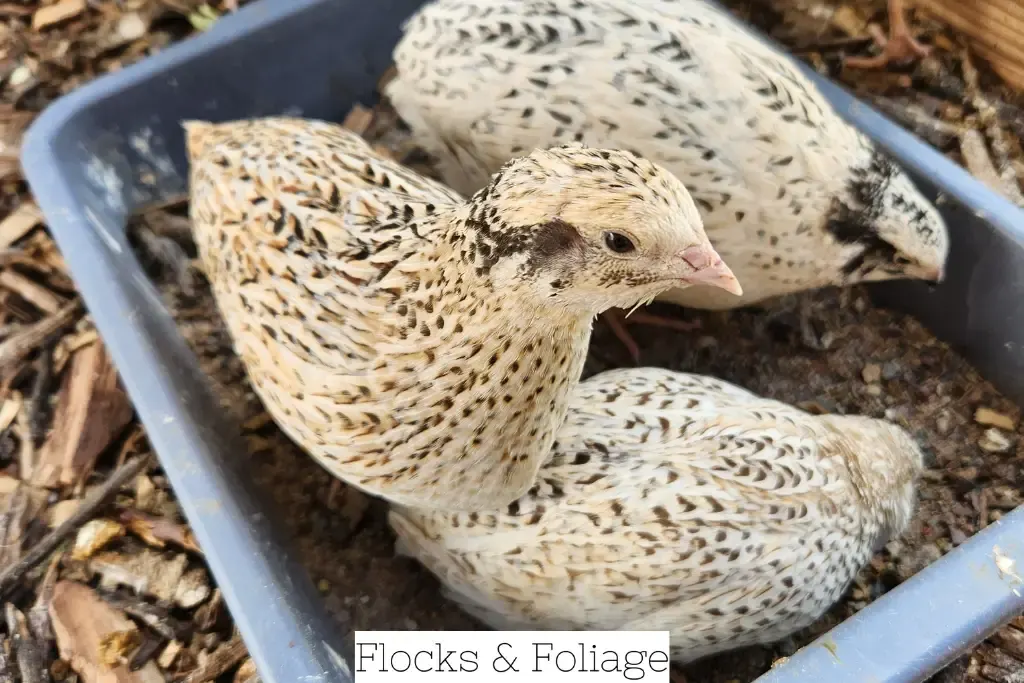
Hatching Your Own Quail Eggs
Quail are one of the easiest birds to hatch yourself in an incubator.
When considering an incubator, try to find one that has a turner that fits quail eggs, as most incubators are built for larger eggs like chickens and ducks.
Once you receive your shipped hatching eggs, place them in the incubator and bring up the humidity to 40-50% humidity and set the temperature to 99.5 degrees Fahrenheit. You will need to ensure that the incubator holds this humidity level consistently for the first 14 days.
After the first 14 days, you will want to put your eggs into lockdown. The lockdown period is when you pull the eggs out of the egg turner and don’t open the incubator at all for the remaining 3 days.
During lockdown, you will keep the temperature at 99.5 degrees Fahrenheit, but you will need to raise the humidity to 60-65%.
It is important that the humidity stays between 60-65% during lockdown so that the chicks can properly pip through the membrane and hatch from the egg.
Once they hatch, leave them in the incubator for 24-48 hours to let them dry off and then they are ready for the brooder.
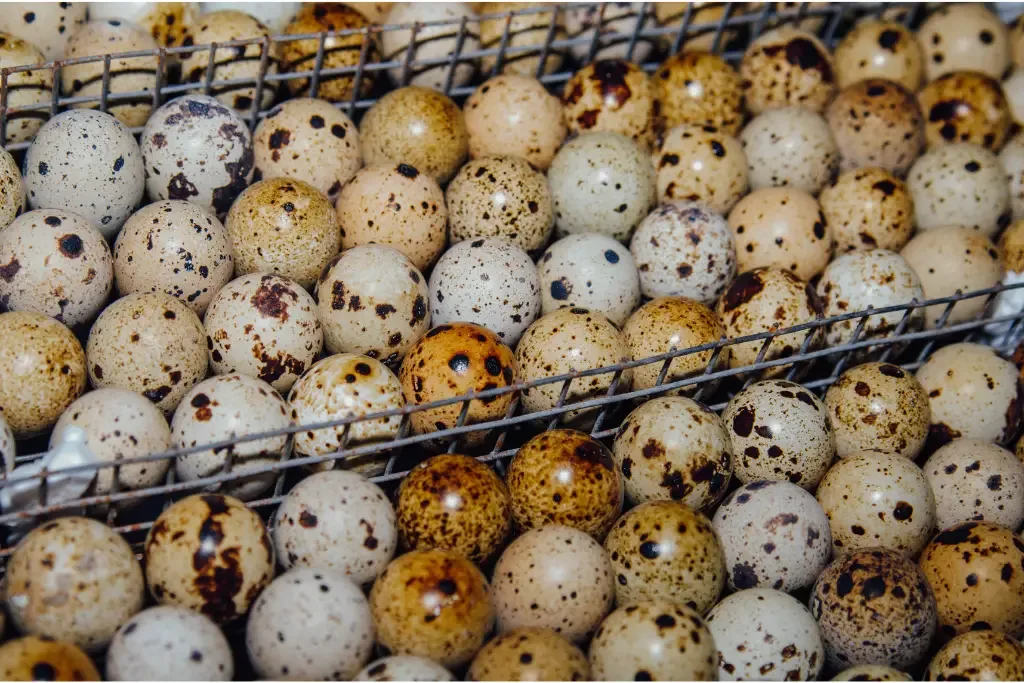
Equipment Needed to Raise Quail
Getting started with quail does not need to be expensive, however, you will want to ensure you have all of the proper equipment before ordering your eggs or purchasing live chicks.
Here are some items you will need to get started:
- An incubator with a quail egg turner (if you plan to incubate and hatch your own eggs)
- Brooder
- Heat lamps or heat plate
- Puppy pads or fine wood shavings for the brooder
- Gamebird starter chick feed
- Gambird layer crumbles
- Waterer(s)
- Feeder(s)
- A predator-proof cage or aviary
- A tub for dust bathing
- Sand for dust baths
- Treats such as dried mealworms or black soldier fly larvae
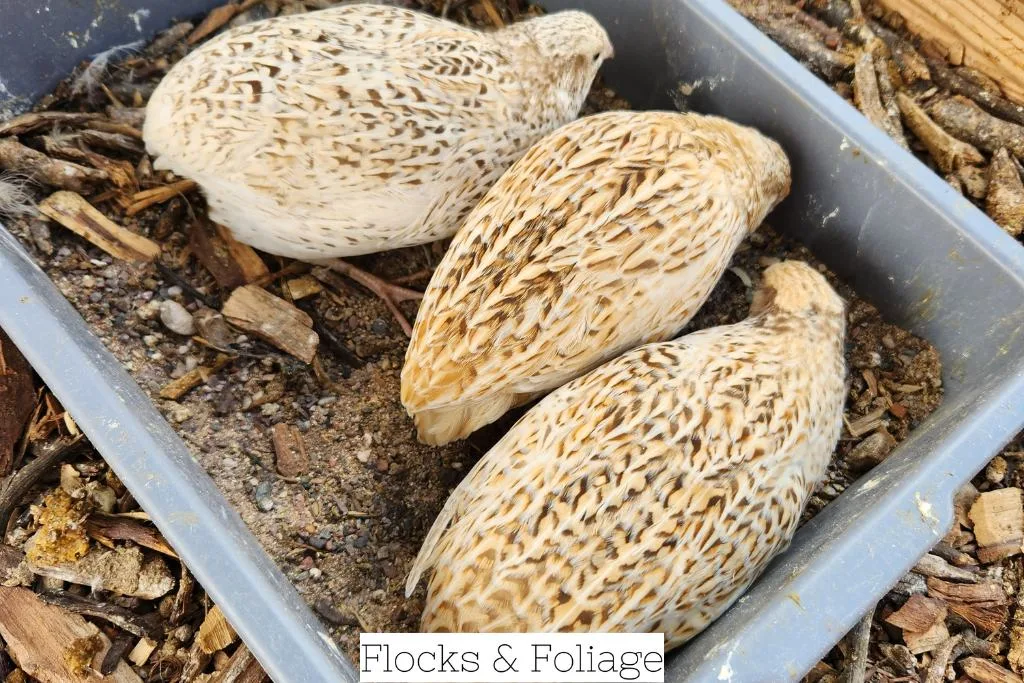
What to Feed Quail
Quail are omnivores, which means their diet must consist of both plant-based and animal-based food.
Most breeds of quail should start on non-medicated gamebird starter crumbles that have been ground up into a fine powder. This can be done in a blender or a food processor.
There are a few different brands to choose from for starter feed. Just make sure you pick one that has a protein content of around 30%.
They only need the ground-up crumbles for the first couple of days and then you can provide them with regular-sized crumbles.
Feeding your quail chicks starter crumble is recommended for about 5-6 weeks of age, at which point you can switch them to non-medicated game bird layer feed that contains around 20% protein.
You may also consider providing them with crushed Oyster shells for added calcium and dried mealworms or black soldier fly larvae for added protein.
Quail also really enjoy eating fruits and vegetables (or scraps) as a treat.
You can feed quail:
- Broccoli
- Cabbage
- Carrots
- Apples
- Watermelon
- Cucumbers
- Turnips
- Peas
- Berries
They can also eat seeds, barley, grass, and leaves.
These items should only be offered as a treat in moderation and should never replace your quail’s regular feed.
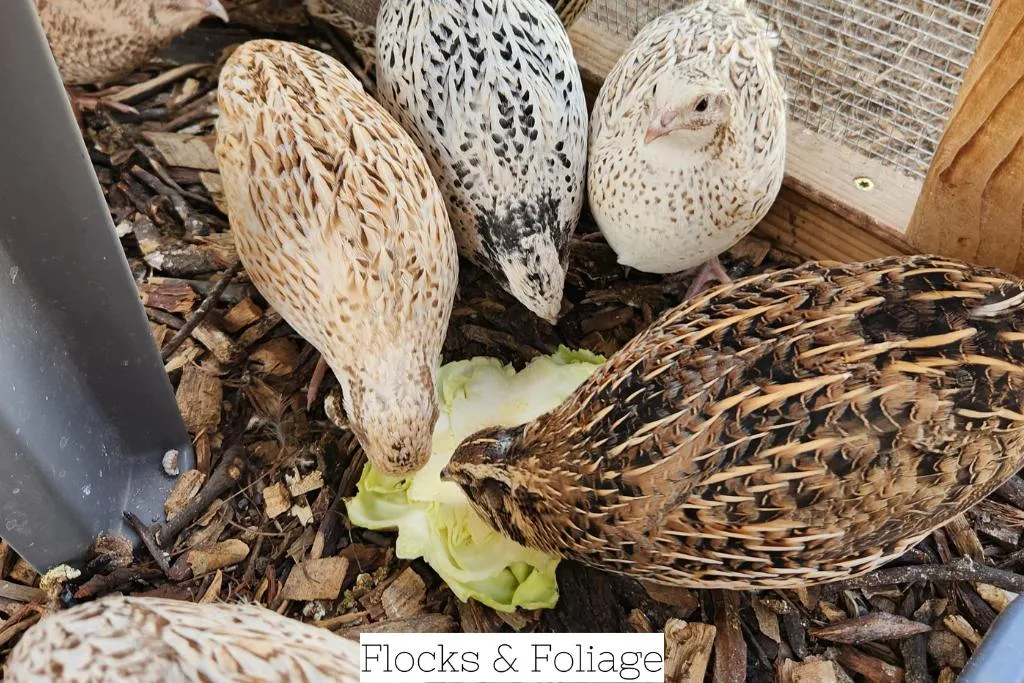
Housing for Quail
The most expensive part of the setup is going to be the cage or aviary that you plan to keep your quail in.
Quail need about 1 square foot of space per bird. If quail are not given enough space, they will become agitated and can severely injure or even kill other quail in the same coop.
Whether you decide to keep them in a cage or a larger aviary/coop, make sure the roof is either below 3 feet or well above 3 feet.
This is because quail tend to “pop up” like popcorn when spooked and if the roof is around 3 feet tall, they can break their neck and die.
Their cage also needs to be predator-proof, and quail have a long list of predators.
The best way to do this is to make sure you staple ¼” galvanized wire on the top, sides, and bottom of your cage or coop. (Yes, even on the bottom. Predators can dig underneath a cage to get to your birds.)
One of the benefits of raising quail is that they do not need roosting bars or nesting boxes.
Unlike chickens, Quail like to be close to the ground at all times and will sleep huddled together on the floor.
And because they don’t go broody often, they tend to lay eggs wherever they are and won’t pay much attention to them after laying them.
It’s important to pick a cage setup that works well with both your budget and your space and one that provides the proper space requirements for your birds.

Common Quail Predators
Quail are small birds and therefore have a lot of predators that are willing to do whatever it takes to get a taste of your birds.
It is important to remember that no matter where you are located if you have quail, the predators will come.
Here are a few common ones to look out for:
Aerial Predators
Aerial predators include:
- Hawks
- Eagles
- Owls
- And other large predatorial birds
Quail are known for hiding in bushes and under rocks and logs in the wild, however, your quail cage or aviary will need chicken wire or mesh on the roof and sides to protect them from aerial predators.
Small Rodents
Rats are one of the most common predators of quail.
They are clever and will find a way to get into a coop or aviary if it is not heavily protected with ¼” galvanized wire on the roof, sides, and floors.
The wire needs to be ¼” or ½” because rats can squeeze through any openings larger than that. And the floor needs to be completely secure because rats are also known for digging under a coop or cage.
Rats will eat quail’s feed, and their eggs, and will even kill and eat your birds.
Larger Animals
Large animals that threaten quail include:
- Opossums
- Fox
- Coyotes
- Raccoons
These predators will do just about anything to get into a quail coop or cage.
Making sure their environment is completely secure will keep these larger animals away from your flock.
Cats
Cats also really love to eat birds.
Feral cats and neighborhood cats will line up to get a taste of your quail.
Again, making sure your cage or coop is secure will allow your flock to stay safe.
Reptiles
Reptiles love to eat quail and quail eggs. These include:
- Snakes
- Large lizards
- Other large and small reptiles
While reptiles aren’t as common in some areas, they are still a threat to your quail and quail eggs and they can easily get into a cage or coop that is not properly secured.
Common Quail Diseases & How to Treat Them
Quail are fairly hardy birds, but even the hardiest of animals can get sick at times.
Here are a few common quail diseases to watch out for and how to prevent and treat them.
Quail Disease (Ulcerative Enteritis)
This disease is one of the most deadly diseases for quail and is named as such.
Quail Disease is an infection that spreads through waste droppings that contain infectious bacteria in it.
When infected, quail will get severe anemia and lesions will appear in their intestines. If not treated immediately, the quail will most likely die.
Quail Disease Symptoms
- Diarrhea
- Lethargy
- Droopy wings
- May not eat or drink
This disease is incredibly infectious and can spread to other types of poultry as well. It is best to completely remove the infected quail from the coop and quarantine it until the disease is properly treated with antibiotics.
In some cases, it is better to remove the affected quail and cull it.
Mites & Lice
Like other poultry, quail are susceptible to lice and mites.
Mites and Lice Symptoms
- Scratching/itching themselves
- Feather Loss
- Dirty/ Dusty looking vents
To treat mites and lice in quail, remove all of the quail from the coop.
Next, you will need to completely clean and disinfect the coop with water and bleach.
Dust the cage with a light layer of diatomaceous earth and then dust your quail with it as well. This will help to kill and deter any leftover mites or lice.
After the cage is completely disinfected and dusted, your quail can go back inside. Continue to dust your quail with the diatomaceous earth once or twice a week for a few weeks to ensure you have killed off all of the mites and lice.
To prevent this issue in the future, keep a dust bath with diatomaceous earth in the quail cage for them to use or offer one a few times per week.
Just make sure that whatever sand you use for the dust bath is natural without any chemicals in it.
Parasites
Quail are also susceptible to parasites like round or tapeworms. Fortunately, this issue is treatable and typically does not kill your quail.
Parasite Symptoms
- Slowed egg production
- May see worms in their stool
- May see worms in their eggs
Parasites can be treated with medication from a veterinarian.
Respiratory Infection
Respiratory infections occur when your quail coop does not have enough ventilation.
Quail droppings contain a high amount of ammonia which causes respiratory issues for your flock.
Respiratory Infection Symptoms
- Difficulty breathing
- Buildup of mucus
- Sneezing
- Listless
- Lethargy
Some quail can fight off this infection on their own with some immune boosters like garlic or apple cider vinegar. However, if the symptoms persist, you may need to take your quail to the vet for antibiotics.
Final Thoughts on Raising Quail
As you can see, raising quail is a great option for both beginner and expert homesteaders.
They provide lots of eggs and are great for their meat, hunting, and more.
If you are looking for an easy, low-maintenance, inexpensive way to put eggs and meat on your dinner table without getting chickens, quail might be a great option for you.
Still not sure? Keep reading below for some frequently asked questions about quail.
FAQs
Do quail fly?
Yes, most breeds of quail have wings and can fly.
However, they do not fly for long distances and do not get very high into the air.
Quail choose to be close to the ground at all times. But it is not uncommon to see them “pop” off the ground and fly in short, sporadic bursts when they get spooked.
Do quail need a coop to go into at night?
While the added protection is appreciated, it is not necessary for quail to have a designated coop that they retreat to at night like chickens.
They are happy to remain in their cage or aviary both day and night.
Quail also do not need roosting bars or nesting boxes. They sleep and lay their eggs wherever they are.

